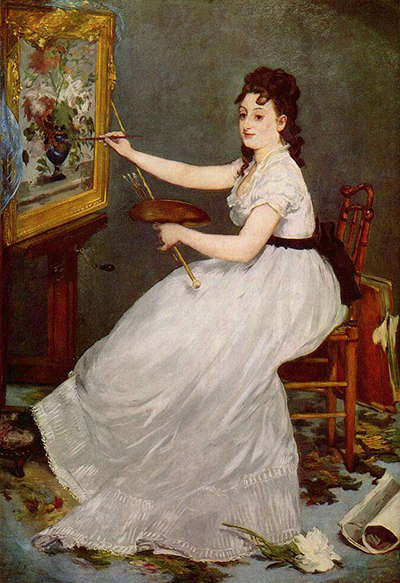This portrait of Eva Gonzales was painted Edouard Manet (1832 – 1883), a French artist of the nineteenth century, and is currently held in the National Gallery in London.
Manet's early work was influenced by the Realist artists of the day but his own artistic instinct was to move away from their subtle blending of light and shade that produced a highly finished realism and, instead, to use bold colours to produce a more realistic sense of the harshness that can result from natural sunlight. Manet's works were often controversial both in terms of their subjects (for example, Le Déjeuner sur l'Herbe (1863) or Olympia (1863)) and the raw freshness of their execution. It was these qualities that attracted the interest of the emerging Impressionist artists. At first sight though, his portrait of Eva Gonzales appears to be a much more conventional work.
The painting, which was completed in March 1870, shows a young woman sitting in front of a still life painting of flowers with her palette and brushes in her left hand while she reaches out towards the painting with the brush in her right hand. She is dressed in a long bluish-white silk gown that shimmers in the light in contrast with a pure white flower on the floor beside her.
It is known that Eva Gonzales (1849 – 1883) was a student of Manet and that she went on to become an accomplished artist in her own right. This was, at that time, unusual as, although young women from prosperous families were encouraged to acquire skills in drawing and painting, it was rare for a woman to attempt to become a member of what would, at that time, have be seen as a male profession. As the art critic, Anne Higonnet, has put it; "Many artists could imagine painting modern women; fewer could imagine a modern woman painting".
This may explain what appears to be Manet’s uncertain attitude towards his subject. Notice that she is not actually looking at the canvas she seems to be working on and her elegant and expensive dress is hardly suitable for the messy business of oil painting. In addition the dress, which was chosen by Manet, is by the standards of the time, very revealing with its low-cut neckline and bare arms and would not have been considered suitable for a society portrait. It is as though Manet does not see before him a woman artist at all but, merely, an attractive young model posing as an artist.




